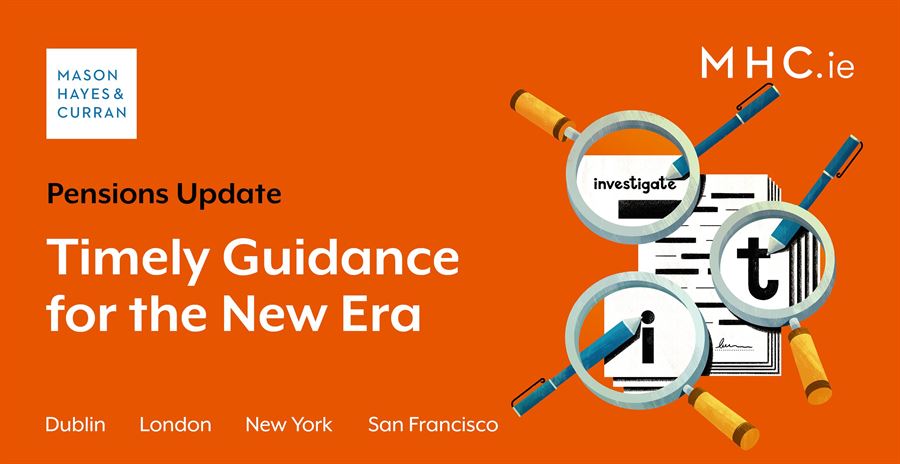Timely Guidance for the New Era: The Pensions Authority’s Information Note on the New Regulations

In line with its proposed schedule of information and guidance in the aftermath of transposition of the IORP II Directive (Directive) into Irish law, the Pensions Authority (Authority) has published its first piece of guidance in the form of a key themes information note (Note) for trustees.
Summary of key provisions
The Note provides a summary of the main provisions of the EU (Occupational Pension Schemes) Regulations 2021 (Regulations). It notes that the Regulations require trustees to put in place effective systems of governance which ensure consistency and regularity for a scheme’s activities. The Note also mentions the need for schemes to have two trustees at a minimum. Alternatively, where a sole corporate trustee acts as the scheme trustee it must have two directors.
The Note also refers to the regulatory requirements relating to the appointment of key function holders (KFHs) to schemes. This includes a risk manager, an internal auditor and, for own funds schemes, the appointment of someone to the actuarial function. The Authority also refers to the written policies which must now be established by trustees for their schemes. These policies include:
-
Key functions (risk management, internal audit & actuarial)
-
Outsourcing, and
-
Remuneration for the trustees, KFHs, other specific categories of staff employed by the trustees, and service providers
The Regulations also introduce a new fit and proper regime for trustees and KFHs. All trustees and KFHs must be of “good repute and integrity” as well as having adequate experience, knowledge, and qualifications to carry out their roles. The Note confirms that the Authority can require trustees to provide information on how they or their KFHs satisfy the fit and proper requirements of the Regulations.
The Note also makes reference to some of the less talked about requirements of the Regulations and the Directive. It refers to “Own-Risk Assessment”, which all trustees must carry out at least every three years. This includes the adoption of risk assessment and risk identification methods by all schemes to complete this self-assessment process. It also refers to the annual compliance return, which trustees will need to submit to the Authority. Further guidance on the compliance return from the Authority is forthcoming.
The Authority’s new powers
The Note explains that the Regulations have provided the Authority with additional powers to issue advisory notices. In addition, it has the power to compel trustees to provide an external report in instances where there is a concern about scheme information provided to it from the trustees. The Regulations also allow the Authority to require trustees to complete stress testing on the scheme’s financial condition.
The transitional measures
The Note also covers the transitional measures that have been put in place for existing one-member arrangements (OMAs) and small trust RACs. It confirms that the five year transitional period for OMAs will end on 22 April 2026, and on 31 December 2021 for small trust RACs. The Note also confirms that there is an exemption for OMA borrowings and investments that were in place before the coming into operation of the Regulations.
Supervisory work and OMAs
The Note suggests that the supervision of OMAs by the Authority will be an immediate concern. The Authority aims to pay particular attention to the establishment date of OMAs to ensure that those schemes that are established after 22 April 2021 are investing and managed in compliance with the Regulations. The Note states that any attempt to mislead the Authority may result in prosecution.
For OMAs that existed before 21 April 2021, the Authority will focus on the new investment and borrowing restrictions that apply from 22 April 2021 onwards.
Master trusts and other schemes
The Note confirms that the Authority will aim to directly engage with master trust providers to assess their scheme’s progress to full compliance with the Regulations. For all other scheme types, including trust RACs, the Authority expects to see evidence of compliance plans which include “specified timelines and progress milestones”. The Note also states that any new scheme established after 1 July 2022 must be fully compliant from the date of establishment.
Conclusion
The Note provided by the Authority is certainly high level. However, it is a useful starting point and the first of many Authority publications on the new Regulations. While many larger schemes will have been preparing for transposition of the Directive for some time, smaller schemes and the providers of OMAs are likely to have more to do in the coming months.
It is clear is that we are entering a new era of regulation of pension schemes in Ireland and trustees and employers alike would be well advised to tread cautiously as we navigate through these virgin waters. Where there is any doubt or confusion about what steps to take in ensuring compliance with the Regulations, legal advice should be sought.
For more information on the impact of the guidance on trustees, contact a member of our Pensions team.
The content of this article is provided for information purposes only and does not constitute legal or other advice.
Share this:




